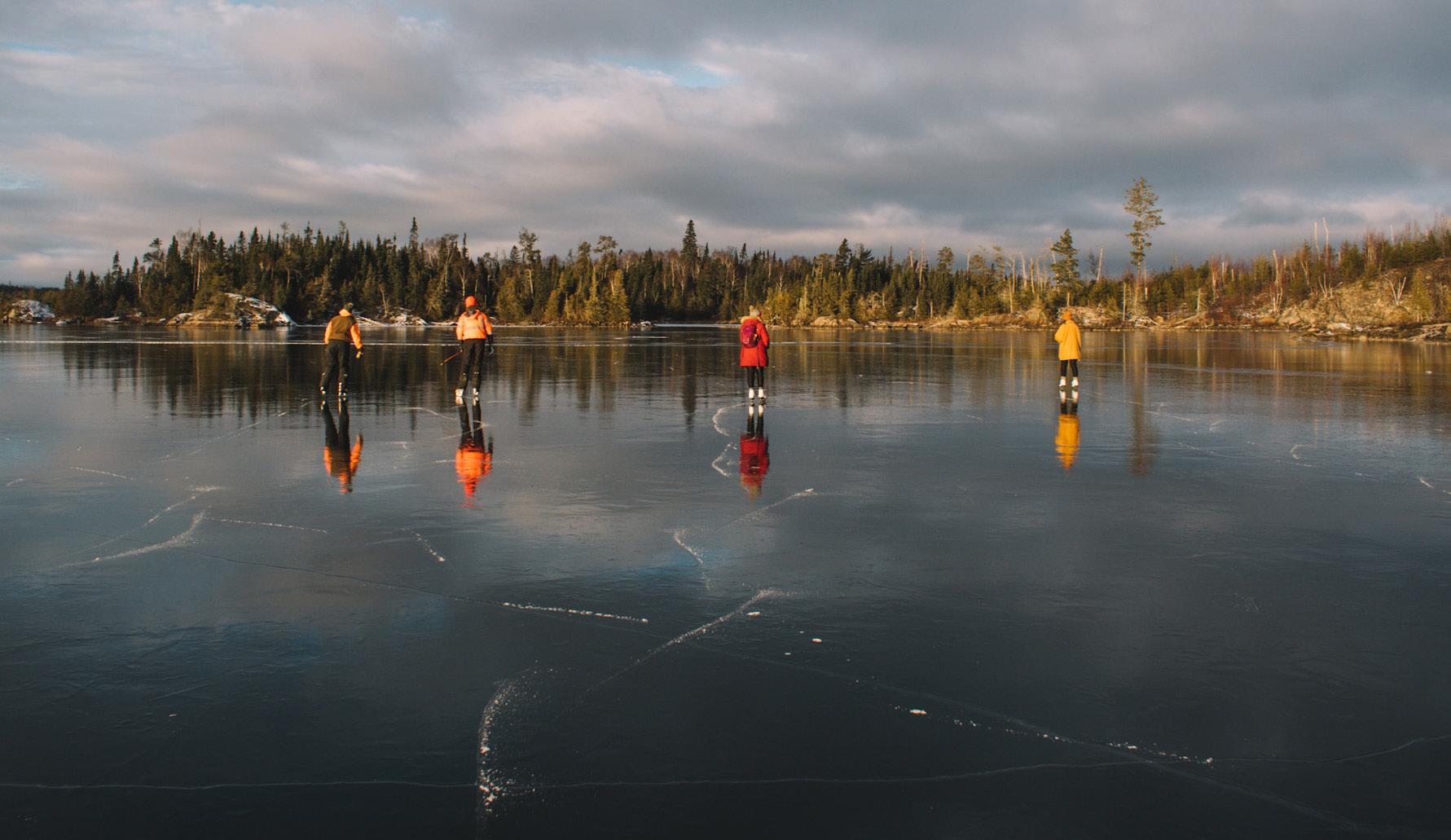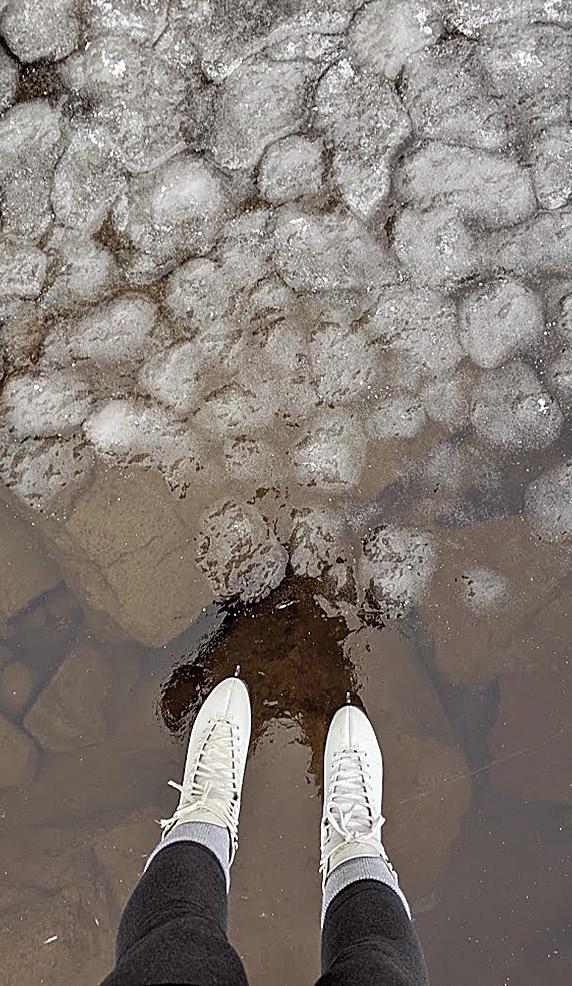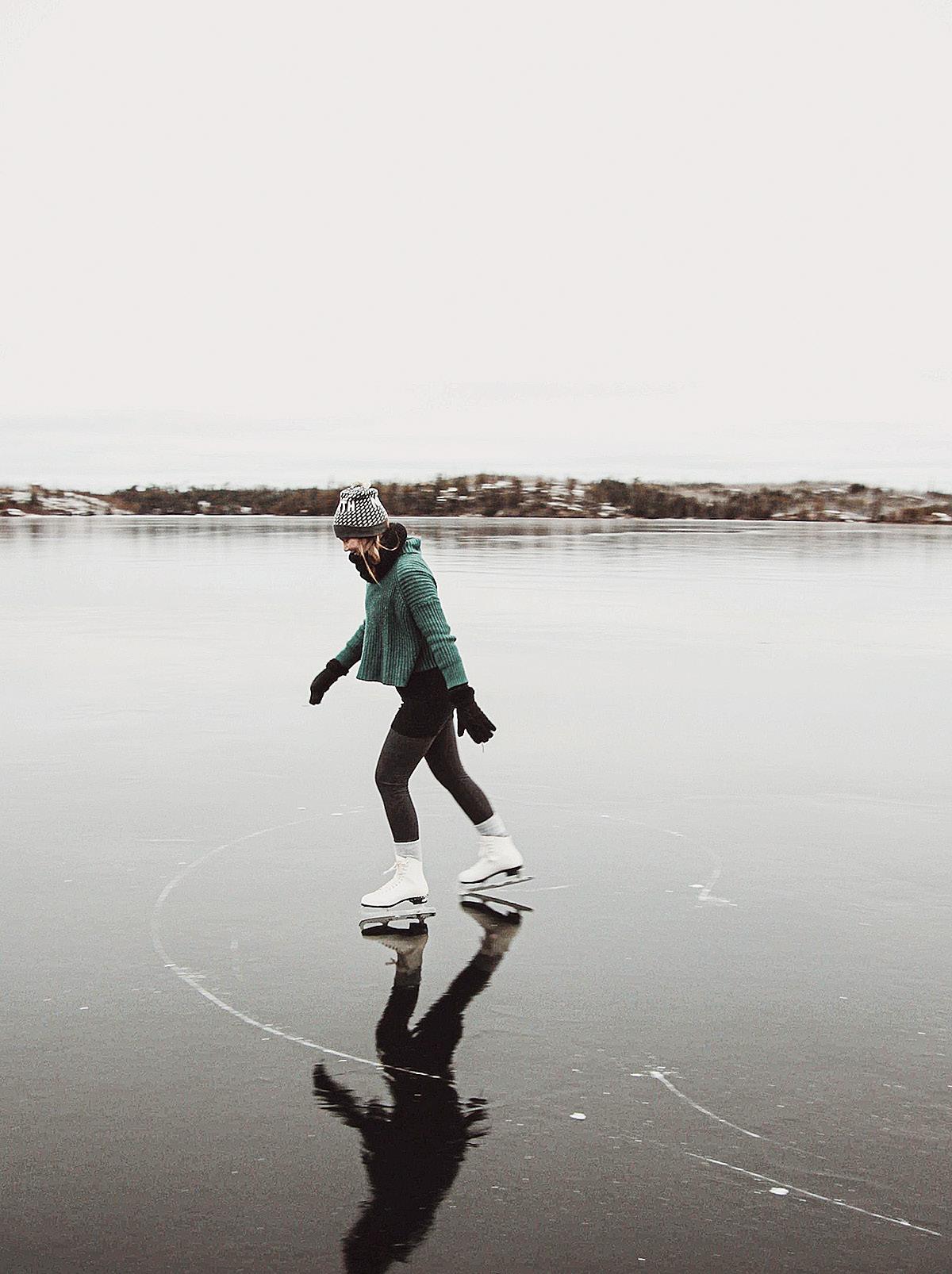
5 minute read
Chasing Wild Ice
In order for wild ice to form, many days of cold temperatures are needed to create a thick layer of ice. If it gets too windy, the wind will make the ice bumpy and opaque. | EMILY RUNNING
The Magic of Frozen Lakes
Advertisement
By Rae Poynter
Last December, the lakes of the upper Gunflint Trail region experienced something that happens every few years: near-perfect ice skating conditions. The waters of the lakes froze into a smooth, glass-like ice, known as wild ice. And smooth ice, of course, means optimal wild ice skating. So what causes ice like this? And what’s the best way to get out and enjoy wild ice skating?
While not all lakes in Northern Minnesota had impeccable ice conditions last year, several of them on the Gunflint Trail did. In order for wild ice to form, many days of cold temperatures are needed to create a thick layer of ice. If it gets too windy, the wind will make the ice bumpy and opaque. And if it snows, the snow will insulate the ice and keep it from thickening. (Not to mention, of course, that the ice needs to be clear of snow in order to skate.) Not every winter brings a stretch of cold, still, and snow-free days, but last year did.
“It seemed like one of those stars-aligning moments where everything has to be just so in order to happen the way it did,” said Cassidy Ritter, manager and part-owner of Voyageur Canoe Outfitters.

Cook County resident Emily Running also made the most of the wild ice last year. | EMILY RUNNING
Cassidy and Matt Ritter had just returned from their honeymoon when their neighbors told them about the ice conditions that had formed. They knew right away that they wanted to go see for themselves.
“We dug out our ice skates and headed over to Seagull Lake with our neighbors and it was absolutely amazing,” Cassidy said. “It is hard to put into words how eerie and beautiful it all was—it was just a really special moment to be able to enjoy with our friends. The Gunflint always has its way of welcoming us home after being away, and this was no exception.”
As word got out about the ice conditions, people traveled up the Gunflint Trail to enjoy the exceptional conditions. Cook County resident Emily Running was one of those who made the most of the wild ice last year.

Not every winter brings a stretch of cold, still, and snow-free days, but last year did. | CASSIDY RITTER
“I had never heard of wild ice before, and didn’t even know what it was,” Running said. “Tuscarora Lodge was posting daily ice condition updates, and I was following their updates and decided to go check it out. I went up on a Friday morning to Seagull Lake, and it was honestly amazing. The ice was so clear that you could see every detail of the rocks below you.”
Running said that the first day she stayed near the boat landing, but that the skating conditions were so enticing that she went up the next day as well, this time skating all the way past the sign that marks the entry to the Boundary Waters Canoe Area Wilderness. Altogether, Running made it to the end of the Gunflint Trail four times to skate on the wild ice.
Some of the lakes last year with wild ice included Seagull Lake, Clearwater Lake and Loon Lake.
“I would say Seagull Lake had by far the best conditions last season,” Cassidy said. “It is such a pristine lake with so much area to cover and such clear water that it made everything that much more amazing. To be able to see the bottom as if the ice you are standing on is not even there at all was absolutely unreal.”
For those wishing to try wild ice skating, Running said that people should be prepared to bring their own skates, as rentals and borrowed skates are difficult to come by. With the unpredictable nature of wild ice formation, those in the area may want to purchase a pair of skates in order to be ready for when the opportunity strikes.

Matt and Cassidy Ritter enjoyed the wild ice last year on Seagull Lake with some friends. | CASSIDY RITTER
In addition to ice skating, wild ice brings the opportunity to experience “singing ice,” or the ethereal sounds made by ice forming. Ranging from deep to high-pitched, the sounds are caused by the ice shifting as it undergoes temperature changes. Ice sounds are easiest to hear before it snows. Running said that they experienced the sounds of the ice cracking as they skated, as well as the unique noises made by skipping rocks across the frozen ice.
“Wild ice is really strong ice, but I still felt uneasy—it’s an eerie feeling being able to see down and knowing there’s water beneath you, water that we had kayaked across earlier that summer,” Running said.
Like any wilderness adventure, especially those involving water, safety is critical for those wanting to enjoy a day out on frozen lakes. Ice needs to be at least 4 inches thick to hold the weight of a person, and weather conditions can make rapid changes to the ice day by day, meaning that it’s always important to measure before going out.
“Safety was one of our main concerns last season when talking to people and sharing that the ice was skateable. We did not want anyone out there to get hurt or be in an unsafe situation,” Ritter said. “It seemed like most people stayed close to shore which is important when you are unfamiliar with the lake you are on or how thick the ice really is. When we went out, we had multiple people with us and we were checking conditions as we went. It is very important to respect the lake you are on and check conditions often because things can change very quickly. Always have someone else with you and have ice picks and a throw bag just in case. Being prepared is always important when enjoying any wilderness area.”
Running said that one of her favorite things about the wild ice was how it brought people out of doors and created a shared sense of joy in the community—something extra meaningful after a year marked by the Covid-19 pandemic.
“There were so many people from Grand Marais out skating. The parking lot for Seagull Lake was completely full! Everyone was so in awe of the ice, and it was great to see people of all ages enjoying it—from toddlers being pulled in sleds to people in their 60s out ice skating. Everyone was having fun,” Running said.

Like any wilderness adventure, especially those involving water, safety is critical for those wanting to enjoy a day out on frozen lakes. | KATIE MUMM







